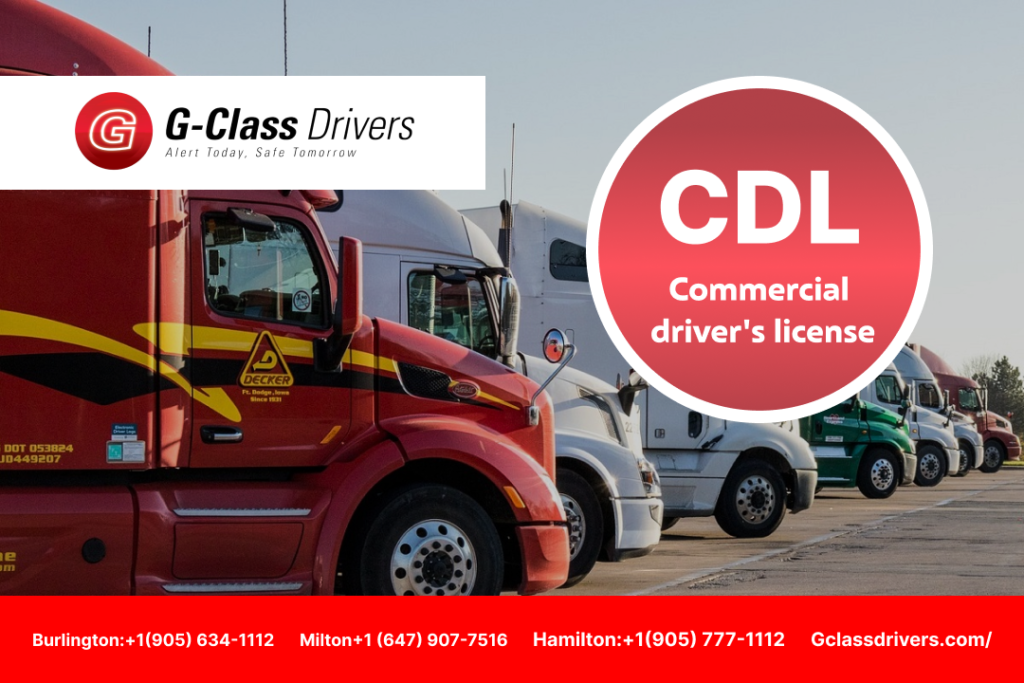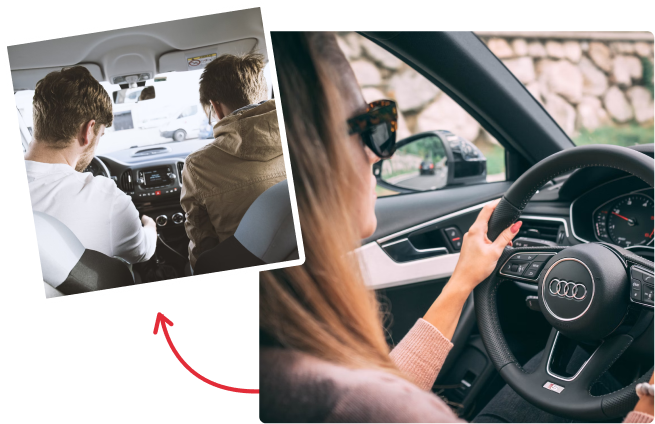What is a Commercial driver’s license?
A commercial driver’s license (CDL) is a driver’s license, required to operate any large or heavy vehicle. This also includes vehicles that carry hazardous material or passengers having a capacity of 15. Obtaining a CDL requires passing a knowledge and skills test specific to the type of vehicle being driven.
Types of Commercial Driver’s Licenses in Ontario
Ontario offers several classes of licenses for operating commercial vehicles, each tailored to specific vehicle types and operational conditions:
Class A
Permits operation of any truck/tractor-trailer combination where the towed vehicles exceed a total gross weight of 4,600 kilograms. Also allows driving vehicles in Classes D and G.
- Restrictions: Do not permit driving passenger buses, motorcycles, or mopeds.
Class A with Condition R (Restricted Class A)
Allows operation of truck/tractor and trailer combinations where the trailer exceeds a total gross weight of 4,600 kilograms, provided the trailer is not equipped with air brakes. Also permits driving vehicles in Classes D and G.
- Restrictions: Prohibits operating vehicles pulling double trailers or trailers with air brakes.
- Transmission Requirements: As with the standard Class A, completing the road test in a vehicle without a manual transmission will result in a restriction from operating manual transmission vehicles.
Class B
Permits driving any school-purpose bus designed to seat more than 24 passengers. Also allows operation of vehicles in Classes C, D, E, F, and G.
- Restrictions: Do not permit driving motorcycles or mopeds.
Class C
Allows operation of any regular bus designed to seat more than 24 passengers. Also permits driving vehicles in Classes D, F, and G.
- Restrictions: Do not permit driving motorcycles or mopeds.
Class D
Permits operation of any truck or motor vehicle combination exceeding 11,000 kilograms gross weight, provided the towed vehicle does not exceed 4,600 kilograms. Also allows driving vehicles in Class G.
- Restrictions: Do not permit driving passenger buses, motorcycles, or mopeds.
Class E
Allows operation of school-purpose buses with a maximum seating capacity of 24 passengers. Also permits driving vehicles in Classes F and G.
- Restrictions: Do not permit driving motorcycles or mopeds.
Class F
Permits driving regular buses with a maximum seating capacity of 24 passengers and ambulances. Also allows operation of vehicles in Class G.
- Restrictions: Does not permit driving motorcycles or mopeds.
Z Endorsement
A Z endorsement is mandatory for operating any air-brake-equipped vehicle. This endorsement can be added to any of the aforementioned license classes.
License Combinations for Commercial Drivers
Drivers have the option to hold multiple commercial license combinations based on their qualifications. For instance, if you meet the requirements for both Class A and Class B, your license will be designated as “AB.” Each license examination is completed separately.
You can also combine a commercial license with a Class M license for motorcycle operations. Such as AM, EM, or ABM, depending on the licenses you hold.
This flexibility allows drivers to operate a wide range of vehicles, enhancing career opportunities and driving skills. If you’re planning to pursue multiple licenses, it’s important to ensure you meet the requirements for each class.
Requirements to Obtain a Commercial Driver’s Licence
If you’re planning to drive commercial vehicles you’ll need to meet several requirements to obtain your commercial driver’s license. Here’s everything you need to know.
Age Requirements
- 19 years or older for Class 1, 2, or 4 licences.
- 18 years or older for a Class 3 licence or a heavy trailer endorsement.
Driving Experience
- You must hold a full-privilege driver’s license (Class 5 or 6) or an equivalent from another province or country.
- New to Canada? Visit the official resources for information on transferring your license.
Driver Training
- For a Class 1 license, completing Mandatory Entry-Level Training (MELT) course may be required. This program ensures that new drivers are trained to handle large commercial vehicles safely.
Commercial Driving Record
- Your driving record must show fewer than four penalty point incidents in the past two years.
- You must also have no driving-related criminal convictions within the last three years.
Fines and Debts
All fines and debts owed to ICBC must be fully paid before applying for a commercial license.
Medical Conditions
- Some medical conditions might affect your eligibility, such as certain types of epilepsy, psychiatric disorders, neurological conditions, heart conditions, diabetes, or sleep disorders.
- Disclose any medical conditions during your application. Your doctor may need to submit a Driver’s Medical Examination Report for further assessment.
- Having a medical condition does not automatically disqualify you; eligibility is determined on a case-by-case basis.
Physical Disabilities
Drivers with physical disabilities, such as amputees, may require prosthetic devices or vehicle modifications to qualify for a license. Specific accommodations can be arranged based on individual needs.
Process for Obtaining a Commercial Driver’s License
Becoming a licensed commercial driver in Ontario involves a series of important steps. From completing medical requirements to passing knowledge and road tests, here’s a comprehensive guide to help you navigate the process successfully.
1. Obtain Necessary Materials
Start by gathering the required resources for your commercial license application.
- You can visit a DriveTest Centre to collect essential materials, including the medical examination report form and Official MTO Handbooks.
- Alternatively, access these resources online or from other providers, such as your physician’s office.
2. Study for the Knowledge Test
Prepare thoroughly for the knowledge test to ensure success.
- Use Ontario’s Official MTO Handbooks to study safety regulations and operational guidelines.
- Review the operator’s manual for the specific vehicle you plan to drive.
- Enroll in driver training programs offered by private driving schools, community colleges, or MTO-recognized employers through the Driver Certification Program (DCP).
3. Complete a Medical Examination
Schedule a visit with a physician or nurse practitioner to complete the medical examination report form.
- Ensure the form is valid (within 180 days) when submitting your licence application.
- Some medical conditions may affect your eligibility; consult with your physician for guidance.
4. Apply for a Commercial Driver’s Licence
Visit the DriveTest Centre to submit your application.
- Bring your valid Ontario driver’s license or acceptable ID.
- Submit the completed medical report form.
- Pass a vision test conducted on-site by a DriveTest customer service agent.
5. Pay the Required Fees
Fees for the application process are set by the Ministry of Transportation of Ontario (MTO) and can be paid at the DriveTest Centre using cash, credit, debit, or other approved methods.
- Note that additional fees apply for retests or subsequent attempts.
6. Take the Knowledge Test
The knowledge test evaluates your understanding of commercial driving regulations and road safety.
- Tests are available on a first-come, first-serve basis, so arrive early, especially during busy periods.
- Class G licence holders may practice driving a commercial vehicle before passing the knowledge test, but most prefer to complete the test first.
7. Practice Driving
Once you pass the knowledge test, practice is crucial.
- Class G licence holders can practice driving a Class A, B, C, D, E, or F vehicle under the supervision of a licensed driver for that class.
8. Book and Complete a Road Test
The final step is passing a road test, which includes a practical driving assessment and, if applicable, a Z endorsement test for air brakes known as the air brake test.
- You must bring a working vehicle of the appropriate class to your road test appointment.
- The road test includes components such as vehicle handling, safety checks, and adherence to regulations.
- If you are unsuccessful, you must wait 10 days before attempting the test again and pay the applicable fees.
Additional Information
- Z Endorsement for Air Brakes: If you’ve completed an air brake course at an accredited school, you may be exempt from taking the Z endorsement knowledge and practical tests.
- CVOR/NEEEP Program: Some applicants may need to complete the Commercial Vehicle Operators Registration (CVOR) or New Entrant Education and Evaluation Program (NEEEP) module. Check with the MTO for details.
G-Class Drivers Can Help You Get Your Commercial Driver’s License
G-Class Driving School is here to make getting your commercial driver’s license (CDL) simple and stress-free. Here’s how we can help:
- Expert Guidance: Our skilled instructors will teach you everything you need to know to drive commercial vehicles safely.
- Specialized Training: We offer training for all licence classes, including Class A, B, C, D, E, and F.
- Air Brake Endorsement (Z): Need a Z endorsement? We’ll prepare you for the air brake test with expert training.
- Test Preparation: From the medical exam to the knowledge test, we guide you through every step of the process.
- Hands-On Practice: Practice driving with our training vehicles to build confidence and pass your road test.
- Flexible Scheduling: We offer flexible class timings to fit your busy schedule.
At G-Class Driving School, we focus on your success. With our training, you’ll gain the skills and confidence to pass your tests and start driving commercial vehicles. Let us help you reach your goals easily and quickly—Contact Us today!





